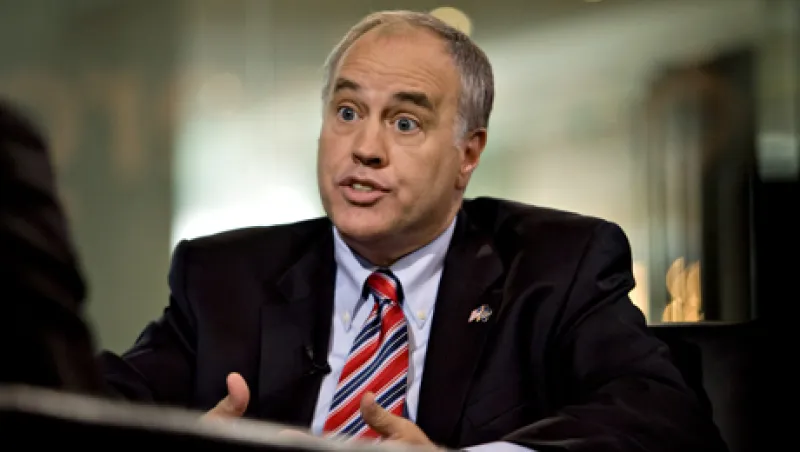As comptroller of the State of New York, Thomas DiNapoli is the sole trustee of the $147.2 billion New York State Common Retirement Fund, the state employees’ defined benefit pension fund. Since his appointment to the office in February 2007, in the wake of predecessor Alan Hevesi’s resignation amid a pay-to-play scandal, DiNapoli, who was elected comptroller in his own right in November 2010, has increasingly raised his voice in support of maintaining and strengthening defined benefit pensions within and outside of the state. He is now calling for the creation of a national commission to ensure retirement income security in the U.S.
In January New York State Governor Andrew Cuomo unveiled the so-called Tier 6 pension plan that would effectively reduce pension benefits for new state employees hired in 2013. The governor and his supporters in the legislature pushed to move state workers to a defined contribution plan, a measure DiNapoli strongly objected to. “In their relatively short 31 year history, 401(k)s have proven to be woefully inadequate for those who depend on them for retirement income,” he stated at a National Institute on Retirement Security conference in early March, adding that 401(k) plans were designed to be supplements to defined benefit (DB) plans and Social Security.
DiNapoli won this round. Next year only nonunion employees including City and State University of New York professors who make more than $75,000 a year will be eligible for the 401(k) option with the adoption of Tier 6. DiNapoli recently invited Institutional Investor Senior Writer Frances Denmark to his New York City office to talk pensions.
Institutional Investor: Why did you fight to keep a defined benefit for new state employees rather than permit the substitution of a defined contribution plan?
DiNapoli: With the Tier 6 debate, people ask me, why are you against 401(k)s? I always have to point out that I am in a 457 plan, which has the same structure.
Even if the proposed plan had been passed with an option to allow for a substitution of a 401(k) style plan for the defined benefit, it was structured so that there would be no requirement for an employee contribution at all. It would be too enticing for too many people to go into it and find out many years later that they made the wrong choice, especially if they hit the market in the wrong way. That isn’t to say that a 401(k) is not a good idea as a supplement to a defined benefit pension as part of your personal savings.
What’s so important about maintaining pension benefits in New York State?
There are many arguments to make about retirement security and people being able to retire with dignity and some sense of confidence. But there is a broader benefit to recycling those dollars within our state. I don’t think we do a good enough job of explaining the benefit to our economy of having people, firemen and police, receive a $19,000 annual payout from our plan. It makes a difference for many retirees between living in New York, with its higher cost of living, and moving to Florida. Close to 80 percent of our retirees continue to stay in New York. We paid out half a billion dollars in benefits last year. That’s 6.5 billion pension checks that stay in New York and don’t go somewhere else. That money gets recycled into our economy.
What’s the biggest challenge in preserving those pensions?
Part of the challenge is getting a balanced picture to the public. The mainstream press takes the worst examples of abuse on the benefit side or a plan that’s in free fall and tries to paint that as being typical and the norm. For every New Jersey, Illinois and Rhode Island, there actually are many more states that are in better shape and have a strong fund that is sustainable for the future. Yet that’s not the impression that’s created.
Tell me about your call for a national retirement security commission, and who you envision on it.
Part of our idea behind the call for a national commission is to look at best practices starting with pubic plans that are working well. What can we do to encourage that to happen in places where it might not be happening? That would include standards for training fiduciaries, imparting an understanding of and commitment to asset allocation and adherence to actuarial standards. Some states have gotten into trouble because they ignored sound actuarial judgment. Besides encouraging best behavior is there something that needs to be done perhaps on a national level in terms of a requirement or law to be sure those best practices are in place?
I think you need a broad range of participants. It might include representatives from government, business, academia and labor. It needs to be more than just a state-by-state discussion — which is what is going on now — because there are common themes.
What kind of solution might result from such a commission?
I think a solution depends on being more creative about providing retirement security for those who don’t have it, whether it’s someone underprepared for retirement in the private sector or the public sector. With people living longer and changed family relationships these days, you can see that in the not too distant future there are going to be increasing numbers of older Americans who can’t provide for themselves. Ultimately, they’re going to come back to government for food or shelter or whatever the necessity is.
Also, to the extent that you’re going to change pension structures, you’re going to have to change federal law. That’s the kind of serious discussion we need to have.






